Related Research Articles

Bombyx mori, the domestic silk moth, is an insect from the moth family Bombycidae. It is the closest relative of Bombyx mandarina, the wild silk moth. The silkworm is the larva or caterpillar of a silk moth. It is an economically important insect, being a primary producer of silk. A silkworm's preferred food is white mulberry leaves, though they may eat other mulberry species and even Osage orange. Domestic silk moths are closely dependent on humans for reproduction, as a result of millennia of selective breeding. Wild silk moths are different from their domestic cousins as they have not been selectively bred; they are thus not as commercially viable in the production of silk.

The buff ermine is a moth of the family Erebidae. It is sometimes placed in the genus Spilosoma. The species was first described by Johann Siegfried Hufnagel in 1766. It is found throughout the temperate belt of the Palearctic region south to northern Turkey, Georgia, Kazakhstan, southern Siberia, eastern Mongolia, Amur Region, China, Korea and Japan.

The cream wave is a moth of the family Geometridae. The species was first described by Adrian Hardy Haworth in 1809. It is found in forest and woodland regions, feeding on grasses and small plants such as dandelion.

Aethes cnicana is a moth of the family Tortricidae. It was described by Westwood in 1854. It is found in Europe, China, Japan, Korea and Russia.
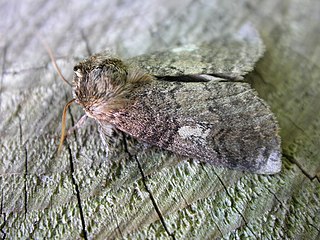
Tethea or, the poplar lutestring, is a moth of the family Drepanidae. It was first described by Michael Denis and Ignaz Schiffermüller in 1775. The species can be found in Europe, northern and eastern Asia and Japan. The imago resembles Tethea ocularis.

Drepana curvatula, the dusky hook-tip, is a moth of the family Drepanidae. It was first described by Moritz Balthasar Borkhausen in 1790 and it is found from Europe to Japan.

Sabra harpagula, the scarce hook-tip, is a moth of the family Drepanidae first described by Eugenius Johann Christoph Esper in 1786. It is found from Europe through temperate Asia to Japan.

Tetheella is a monotypic moth genus in the family Drepanidae described by Werny in 1966. Its single species, Tetheella fluctuosa, the satin lutestring, was described by Jacob Hübner in 1803. It is found from western Europe to Kamchatka, Sakhalin Island, Korea and Japan.

Ochropacha is a monotypic moth genus in the family Drepanidae. The genus was first described by Wallengren in 1871. Its single species, Ochropacha duplaris, the common lutestring, was first described by Carl Linnaeus in 1761. It is found in China (Jilin), Russia, Japan, the Korean Peninsula and from Central Asia to Europe.

Gagitodes sagittata, the marsh carpet, is a moth of the family Geometridae. The species was first described by Johan Christian Fabricius in 1787. It is found in eastern Asia, including Japan, Korea and China and in central and northern Europe. It is sometimes included in the genus Perizoma
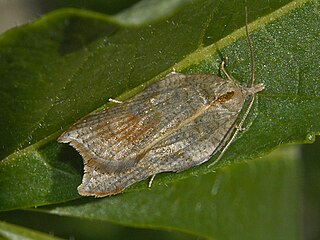
Acleris emargana, the notched-winged tortricid, is a moth of the family Tortricidae. The species was first described by Johan Christian Fabricius in 1775.
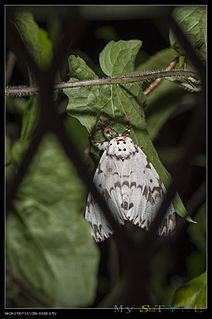
Lymantria mathura, the rosy gypsy moth, is a species of moth of the family Erebidae found in the Russian Far East, Nepal, Japan, the Korean Peninsula, northern India and China. The species was first described by Frederic Moore in 1866.
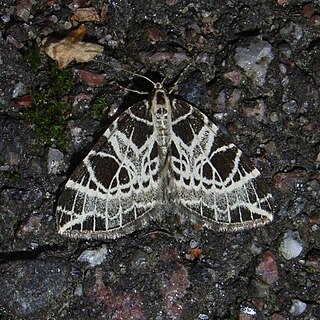
Eustroma reticulatum, the netted carpet, is a moth of the family Geometridae. The species was first described by Michael Denis and Ignaz Schiffermüller in 1775. It is found in Europe, western and central Siberia, northern Mongolia, the Amur region, Khabarovsk, Primorsk, Sakhalin, Kurils, China, the Korean Peninsula and Japan. It is one of the rarest moth species in Great Britain.

Erebus ephesperis is a moth of the family Erebidae first described by Jacob Hübner in 1827. It is found in Asia, including India, Japan, the Korean Peninsula, China, Singapore and Borneo.
Stenodacma pyrrhodes is a moth of the family Pterophoridae. It has a wide range and has been recorded from Australia, India, Japan, South Africa, China, Nepal, Pakistan, Sri Lanka, Vietnam, Thailand and Korea. The species was first described by Edward Meyrick in 1889.

Rehimena surusalis is a species of moth of the family Crambidae described by Francis Walker in 1859. It is known from Australia, China, the Andaman Islands, Sri Lanka, Indonesia, Taiwan, Korea and Japan.
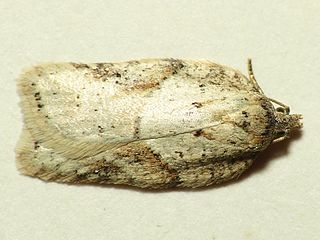
Acleris logiana, the black-headed birch leaffolder moth or grey birch button, is a moth of the family Tortricidae. It was described by Carl Alexander Clerck in 1759. It is found in most of Europe, except Ireland, Portugal, most of the Balkan Peninsula and Ukraine. It is also found in North America, the Russian Far East, Korea and Japan.
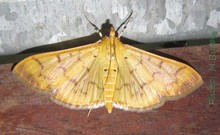
Patania balteata is a moth of the family Crambidae. It was described by Johan Christian Fabricius in 1798. It is found across southern Europe, Africa and Asia, including Japan, Korea, Réunion, Madagascar, Taiwan, Thailand, Turkey and Ukraine, as well as New South Wales and Queensland in Australia. There is also an old record from Hawaii.
Monochroa hornigi, the knotweed neb, is a moth of the family Gelechiidae. It was described by Otto Staudinger in 1883. It is found in most of Europe, European Russia, western and south-eastern Siberia, Transbaikalia, Korea and Japan (Hokkaido).
Thecobathra anas is a moth in the family Yponomeutidae. It was described by Stringer in 1930. It is found in Korea, Japan and Indonesia.
References
- ↑ "GlobIZ search". Global Information System on Pyraloidea. Retrieved 2011-09-29.
- ↑ A review of the tribe Pyralini Latreille (Lepidoptera, Pyralidae, Pyralinae) from Korea
- ↑ Japanese Moths
| This Pyralinae-related article is a stub. You can help Wikipedia by expanding it. |